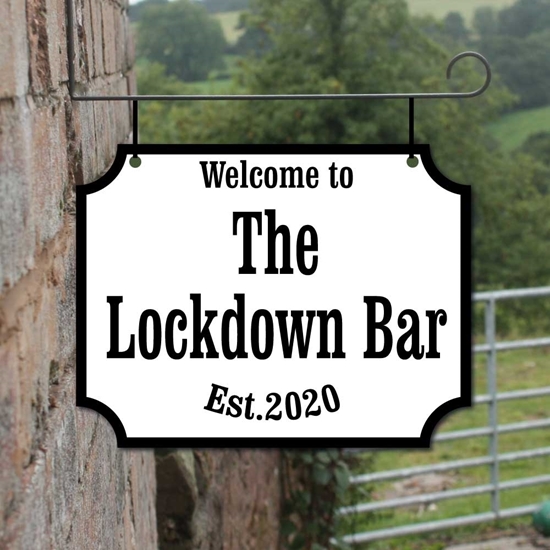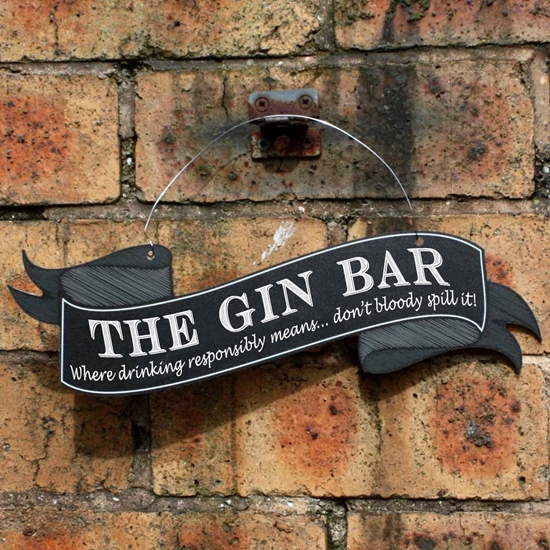Handy Advice To Selecting Gin Bar Signs
Wiki Article
What Are The Differences In Bar Signs?
Material is an important element in the design of bar signs. Each material comes with its own distinct features and advantages that are suited to different goals and styles. Here's a look at the materials used for bar signs and their differences. Wood
Characteristics: Natural, rustic, warm.
Durability : Most durable but vulnerable to the effects of moisture and regular maintenance.
Uses: Ideal for rustic or vintage themed bars, name boards, menu boards and customized signs.
Customization: Can either be stained, carved or painted. The options for finishing are endless.
2. Metal
Characteristics: Sleek, modern, industrial.
Durability - Extremely durable and weatherproof, and suitable for indoor and outdoor use.
Uses: Great for bars with a modern or industrial theme as branding signs, as well as robust informational signs.
Customization: Can be laser-cut or embossed, or even painted. Commonly used for intricate designs and logos.
3. Neon
Characteristics: Bright, eye-catching, retro.
Durability The material is not as durable in comparison to other materials. However, it will last for a long time if well maintained.
Uses: Great for bright, attention-grabbing signs as well as branding and creating a retro ambiance.
Customization is limited to outline forms and text because of the nature neon tubing. Available in different shades.
4. You can also find out more about Acrylic
Characteristics: Versatile, lightweight, modern.
Durability: This fabric is not prone to fading.
Uses include: Modern sleek signs, modernized featuring illuminated letters, intricate logos, and modern signage.
The possibility of customization is there Printing them or laser-cutted. Or they can be combined to create an illusion of 3D. Available in a variety of colors and finishes.
5. Vinyl
The characteristics are flexible, adaptable and simple to use.
Durability: It is suitable for temporary or semi-permanent applications. High-quality vinyl can endure outdoors.
Uses: Perfect for window graphics or temporary promotional materials and custom decals.
Customization: Very customizable with printed designs, cut-out shapes and a variety of colors. Easy to apply.
6. Chalkboard
Characteristics: Functional, rustic, interactive.
Durability It requires regular maintenance (cleaning and chalk replacement). Can be damaged if not cared for properly.
Uses: Great for menu boards. Also great as interactive signs for places that are frequently updated with information.
Customization: Handwritten messages and designs are possible. To ensure durability, you can choose to frame your artwork with different materials.
7. Glass
Characteristics: Elegant, sleek, modern.
Durability - It is fragile, but can become durable when tempered. Most often, backlighting is used to create an added effect.
Uses : Great for branding signs using high-end quality, high-end lighting, as well as window displays.
Customizations: They may be painted, printed, or etched. Lighting is frequently used to create an eye-catching appearance.
8. PVC (Polyvinyl Chloride),
Characteristics: Lightweight, versatile, cost-effective.
Durability: Weatherproof and durable, suitable for both indoor and outdoor use.
Uses: Commonly used for temporary signs, events promotion, and lightweight branding signs.
It is possible to customize: print, paint, and cut into different shapes. Available in several sizes.
9. LED
Characteristics: Energy-efficient, bright, modern.
Durability: Highly robust and durable, suitable for long-term use.
Uses: Perfect for illuminated signs, modern branding and creating vibrant lighting effects.
Customization: Available in many colors, and can be programmed to alter messages or even animations.
10. Foam Board
The lightweight, low-cost and simple to use.
Durability : Not as durable. It is recommended for indoor temporary uses.
Applications: Ideal for temporary promotions or events, as well as informational signs.
Customization: You can either print on it or apply it to vinyl. It is easy to cut into different shapes and sizes.
The material for the bar sign has distinct properties that affect its appearance as well as its durability and suitability in different environments. The selection of the material you pick is contingent on your intended application and your aesthetic preferences, as well as your budgetary limitations. Follow the top top article for bar runners for blog tips including outdoor personalised bar sign, large bar signs, pub bar signs, large pub sign, hanging pub signs for sale, pub signs made, hanging bar sign, personalised hanging bar sign, bar hanging sign, home garden bar signs and more.

How Do Bar Signs Differ In Terms Of Customization And Personalization?
Signs for bars offer a wide selection of customization and personalization options that reflect the distinctive brand, ambience and design of every establishment. The following are the differences between bar signs in regards to customization and personalization. 1. Material
Flexible Material: Woods, metals and acrylics.
Personalization - Select the right materials to fit the theme of your bar.
2. The Design
Custom Graphics can include designs, logos, typography or artwork.
Personalization - Integrate unique brand elements and imagery or theme-based designs to create a unique bar atmosphere.
3. Size and Shape
Custom sizes From tabletop signage to large marquees for outdoor use.
Personalization: You are able to alter the dimensions and shape of your signs to satisfy your branding needs. This could include oversized letters for a bold art piece, or smaller signs for smaller spaces.
4. Color
Custom Color Schemes Custom Color Schemes Pantone matching options, RGB options and custom finishing.
Personalization: Select colors to reflect the bar's interior decor or target audience preferences. They can be vibrant and striking.
5. Lighting
Custom Lighting Effects Neon LED backlit edge-lit projections or other.
Personalization: Choose lighting options which enhance the ambiance and visibility while blending with the theme of the bar and mood, such as neon to create a retro feel or LED for a modern accent.
6. Text Messages
Custom Text: Bar name, slogans, quotes, menu items, event announcements.
Personalization: Craft messaging that is exclusive to the establishment, resonates with its patrons and communicates effectively promotions, specials and values of the brand.
7. Interactivity
Custom Interactive Features: Digital displays, QR codes or interactive projections.
Personalization: Utilize interactive elements like digital menus or games to provide memorable experiences and to make your customers feel more involved.
8. Mounting & Installation
Custom Mounting Solutions for Wall-mounted or hanging, freestanding or window-mounted.
Personalization: Select mounting options that complement the bar's layout, increase visibility, and integrate seamlessly with the overall design, whether sleek and minimalistic or bold and attention-grabbing.
9. Specialized for events and seasonal seasons
Custom Themes. Holiday decorations themes, themed themes for the holidays or themed occasions.
Personalization: Make sure that signs are updated to reflect seasonal changes holiday, seasonal changes, and other special occasions. It creates a fun environment for the patrons.
10. Brand Consistency
Custom Branding Elements : Logos images, fonts, colors and colors.
Personalization: Make sure you are consistent with your signage and branding materials to build brand recognition, strengthen brand recognition and create an enjoyable and memorable experience for customers.
Benefits from Personalization and Customization
Brand Differentiation: Stand out and make a lasting impression.
Brand Identity Reinforce your brand's identity to increase customer loyalty.
Atmosphere enhancement: Match the signage to the bar's environment and the desired atmosphere to enhance the experience for customers.
Signs that are personalized can stimulate interactions, stimulate conversation, and generate excitement.
Utilizing the personalized and customizing features bar owners can design distinctive, memorable signs that do not just convey information but also enhance the aesthetics, ambience branding, and overall appearance of their establishment. Follow the top bar signs for home bar for website tips including hanging home bar signs, pub signs personalised, buy bar signs, indoor bar signs, bespoke bar signs, pub wall sign, personalised home pub sign, buy bar signs, hanging pub signs, design a pub sign and more.

What Are The Distinctions Between Bar Signposts And Regulations?
Bar signs are subjected by diverse regulations imposed by local, state and federal authorities to ensure safety for the public, aesthetic standards as well as compliance with the zoning regulations. The following are the types of bar signs that are subject to different regulations: 1. Size and placement regulations
Zoning laws: These regulations determine the size the height, distance and location of signs from properties or adjacent buildings.
Historical Districts: Restrictions may apply to preserve the historical character of certain areas that limit the design, size and materials of signs.
2. Illumination Restrictions
Regulations on Light Pollution: Limit the brightness, color and duration of signage that is illuminated to reduce light pollution and preserve the nighttime atmosphere.
Safety considerations: Signs shouldn't create glare that can cause distraction to pedestrians and drivers.
3. Content from the Signage
Alcohol Advertising Certain jurisdictions limit alcohol advertisements by preventing certain images and content that could be appealing to minors.
Health Warnings: The law could mandate health warnings be included on signage pertaining to alcohol consumption and smoking.
4. Historic Preservation Regulations
Architectural Compatibility. Signs in historic districts should be in line with the architectural design and the character of the area. In most cases preservation committees or boards are required to approve signs.
Materials and Design. Limitations on the materials used for signs, design and color schemes may be applied to maintain the historic integrity.
5. Sign Permitting Process
Permits are needed: Owners of bars need permits to set up or alter signs. This can require submitting drawings, and paying for fees, as well getting approval from the local authorities.
Code Compliance: To guarantee public security and accessibility, signs must adhere to building codes, safety regulations, and accessibility standards.
6. Maintenance and removal of signs
Maintenance requirements. It is the responsibility of the owner of the bar to ensure that signs are kept in good condition and structurally sound, free of hazards, and conforming to regulations.
Abandoned Signs: Regulations may be enacted to remove old and deteriorated signs to avoid blight while maintaining the aesthetics of the surrounding area.
7. Digital Signage Regulations
Content Restrictions - Laws can restrict the content displayed on digital signage, for example by preventing flashing lights and offensive imagery.
Limitations on operation: Regulations may limit the brightness, speed or frequency with the time digital signs change in order in order to limit visual confusion.
8. Enforcement and Penalties
Inspections Local authorities conduct routine inspections to verify the compliance of signage regulations and issue citations for violators.
Penalties - Penalties can include fines or court orders, requests for signs to be removed or changed and legal actions.
9. Sign Process
Variance applications Bar owners who want to deviate their signage from the rules can do it by submitting a request for an exemption. Justification should be provided as well as any negative effects on the public's safety or appearance should be mitigated.
Public Input: Certain issues may require public hearings or input from community members or property owners in neighboring properties or business associations.
10. Community Engagement and Input
Public Consultation. Some jurisdictions invite citizens to be part of the creation of regulations for signs by attending public meetings and surveys.
Community Benefits: Sign regulations can include provisions that enhance the visual quality of signs and promote local businesses or aid in revitalizing neighborhood efforts.
In compliance with signage regulations, bar proprietors can ensure that the signage they choose to use improve the aesthetic appeal and value of their business as well as benefit the community. They'll also be legally compliant and reduce the chance of fines, penalties or legal battles. Have a look at the top rated more info about pub bar signs for website tips including personalised signs for home bar, personalised pub signs for sale, signs for garden bar, personalised sign for bar, the staying inn pub sign, cocktail bar sign, personalised outdoor bar signs, bar pub signs, personalised metal pub signs, make a pub sign and more.
